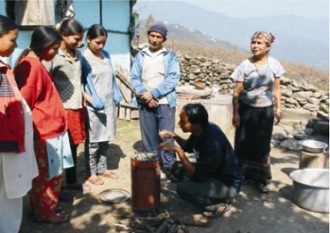KATHMANDU, Sept 12: A recent study on the impact of climate change on Nepal´s development and climate change induced uncertainties has concluded that the increase in the number and intensity of natural disasters will prevent many Nepali households from breaking through the poverty line. It has projected that the flood impact on each household will double and the number of households affected directly will increase by 40 per cent.
“As temperatures increase and the climate becomes more erratic, the incidence of forest fires may increase, thereby reducing the amount of mean residual energy available in forests for use by local communities,” the report titled “Vulnerability through the Eyes of the Vulnerable: Climate Change Induced Uncertainties and Nepal´s Development Predicaments” prepared by national and international experts with support states.
Stating that Nepal´s population is now leaning toward the service sector (as opposed to the manufacturing sector), which is less resource intensive and polluting than fossil fuel-based industrial production, it said the government´s existing energy policy is inadequate to respond to the future challenges.
The report funded by UK´s Department for International Development added that Nepal is burdened by a slow-growing, supply driven-energy monopoly. In addition, the government´s subsidization of electricity for a few (5% of rural and 20% of urban dwellers), and imported petroleum products indirectly taxes the most vulnerable sections.
Drawing analysis from eight significant events — 1998 Rohini River flooding and other floods in Tarai, last year´s Koshi embankment breach and floods in the farwestern region, 1993 mid-mountain cloudbursts and floods, recent glacial lake outburst, 2008-09 winter drought, and this year´s forest fires across the Himalayan region and the cholera epidemic in the far and mid-western hills — and unusual rainfall pattern, the report concludes that the intensity and frequency of these events means that development planning must learn to deal with increased intensities of such disasters. Moreover, it said the country´s institutions and governance structures must “improve substantially” if such events are to be highly minimized.
The report, prepared by Nepal Climate Vulnerability Study Team and published by Institute for Social and Environmental Transition Nepal, specifies three recommendations.
First, provisioning reliable supply of electricity can function as “an essential gateway service to help build people´s adaptive capacities through income diversification.” It said empowering local institutions to implement decentralized renewable energy systems already found in Nepal, including solar, small and medium-scale hydroelectricity, wind and biogas systems will halt the widespread burning of biomass as well as create many “green jobs.” This will also reduce emissions and reverse the ongoing loss in the “sequestering potential of Nepal´s national and community forests.”
Second, developed nations should pay Nepal energy compensation for exposing it to climate stresses associated with fossil fuel which will provide financial incentives to switch away from fossil fuel to an adaptive and non-polluting development pathways. The cost of this would be about US$44 million per year for next 20 years.
Third, the government must introduce well-designed incentives and policies that help channel remittance inflows towards climate-resilient investments.
The report also quotes the latest GCM (General Circulation Model) projections that indicate an increase in temperature over Nepal of 0.5-2.0 degree Celsius with a multi-model mean of 1.4 degree Celsius, by the 2030s, rising to 3.0-6.3 degree Celsius, with a multi-model mean of 4.7 degree Celsius, by the 2090s.



